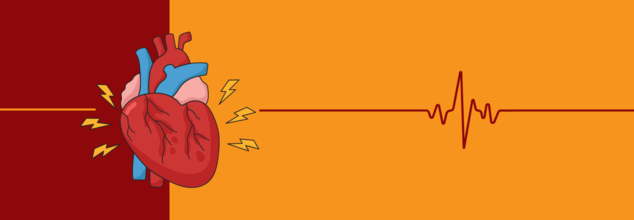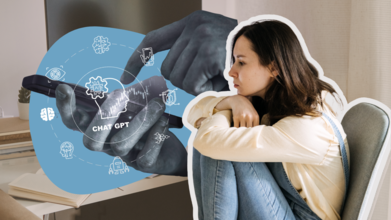- Health Conditions A-Z
- Health & Wellness
- Nutrition
- Fitness
- Health News
- Ayurveda
- Videos
- Medicine A-Z
- Parenting
- Web Stories
Decoding Heart Emergencies: Cardiac Arrest Vs Heart Attack

Heart Health (Credit: Canva)
The terms 'cardiac arrest' and 'heart attack' are often used interchangeably, but they refer to two distinct medical emergencies with different causes and treatments. Both conditions are life-threatening and require immediate medical attention. Here, it is important to note that both emergencies are linked to Coronary Heart Diseases (CHD), which are responsible for 1 in every 3 deaths across the world.
How Is A Heart Attack Different From A Cardiac Arrest?
Heart Attack (Myocardial Infarction)
A heart attack occurs when blood flow to a part of the heart muscle is blocked, typically by a blood clot in a coronary artery. This blockage prevents oxygen-rich blood from reaching that part of the heart muscle, causing damage or eventual death of that muscle tissue.Common symptoms include chest pain or discomfort, shortness of breath, nausea, sweating, and pain in the arm, back, or jaw. Symptoms can vary and may be less obvious in some individuals.
Treatment for a heart attack often involves medications to dissolve the clot, restore blood flow, or prevent further clots, along with procedures like angioplasty or stenting. Lifestyle changes and cardiac rehabilitation are also recommended for recovery.
Cardiac Arrest
Cardiac arrest occurs when the heart suddenly stops beating effectively due to an electrical malfunction in the heart. This leads to a loss of heart rhythm (arrhythmia), such as ventricular fibrillation or ventricular tachycardia, and prevents the heart from pumping blood to the rest of the body.Symptoms include sudden collapse, loss of consciousness, and absence of pulse or breathing. Cardiac arrest often occurs without warning and is an immediate medical emergency.
Immediate treatment involves cardiopulmonary resuscitation (CPR) and defibrillation (using an automated external defibrillator or AED) to restore a normal heart rhythm. Prompt medical intervention is crucial for survival and recovery.
| ASPECT | Cardiac Arrest | Heart Attack |
| Definition | Sudden loss of heart function due to an electrical malfunction | Blockage of blood flow to a part of the heart muscle due to a blocked artery |
| Cause | Electrical malfunction in the heart's rhythm (arrhythmia) | Plaque buildup in the coronary arteries (atherosclerosis) |
| Symptoms | Sudden collapse, loss of consciousness, no pulse, no breathing | Chest pain or discomfort, shortness of breath, nausea, sweating, pain in arm or jaw |
| Onset | Immediate and abrupt; occurs suddenly without warning | Gradual; may start with mild symptoms that worsen over time |
| Immediate Treatment | Cardiopulmonary resuscitation (CPR) and defibrillation (if needed) | Medication to dissolve clots, angioplasty, or stent placement; sometimes surgery |
| Long-Term Management | Focus on addressing the underlying cause of arrhythmia, such as implantable defibrillators or medication | Lifestyle changes, medications, and possible surgical interventions to manage coronary artery disease |
| Prevention | Regular cardiovascular check-ups, managing risk factors, and addressing arrhythmias | Healthy diet, regular exercise, managing cholesterol and blood pressure, quitting smoking |
| Prognosis | High risk of sudden death if not treated immediately; survival often depends on prompt intervention | Varies; many people recover with treatment, though heart damage can occur if not treated promptly |
How Can You Prevent Heart Emergencies
Both heart attack and cardiac arrest can be caused due to Coronary or ischemic heart disease (CHD). Therefore, it is pivotal to maintain good heart health. Following are the precautionary tips you can use to prevent CHD, as per World Health Organization (WHO).
Adopt a Heart-Healthy Diet: Focus on a diet rich in fruits, vegetables, whole grains, legumes, and nuts. Reduce intake of salty meats, processed foods, and sugary snacks. Opt for natural seasonings like calamansi juice and vinegar instead of high-sodium condiments, and drink water instead of sweetened beverages.
Manage Your Weight: Achieve and maintain a healthy weight by aiming for a BMI below 25 and reducing central obesity. Cutting 500 calories from your daily intake can help you lose about half to one kilogram per week.
Increase Physical Activity: Aim for at least 150 minutes of moderate exercise per week, such as brisk walking or gardening. Regular physical activity helps manage blood pressure, cholesterol, and weight.
Avoid Tobacco: Refrain from smoking and exposure to second-hand smoke. Quitting tobacco reduces your risk of heart disease significantly over time.
Limit Alcohol Consumption: Although occasional drinking is common, avoid alcohol entirely to minimize cardiovascular risk. There is no safe level of alcohol consumption for heart health.
Monitor Blood Pressure and Sugar Levels: Regularly check your blood pressure and blood sugar with a healthcare provider. Unchecked high blood pressure can damage your heart. If diagnosed with hypertension or diabetes, adhere to your treatment plan and involve your loved ones in your health journey.
Tall Poppy Syndrome: Why 'Standing Out' At Work Can Affect Your Mental Health, Especially For Women

(Credit- Canva)
Doing well at work, being acknowledged and being celebrated for it is one of the best feelings to have. But is that all? Have you ever wondered how being celebrated like that ends up with that person as target of criticism and harsh words?
For many people, especially women, achieving success at work can come with an unexpected mental health cost. This is because of something called "Tall Poppy Syndrome," where people who stand out and succeed are intentionally "cut down" by others. Instead of celebrating their achievements, colleagues may show silent resentment, undermine them, or even bully and exclude them. A report was done to understand who this issue affects as well as how it affects them.
What is The Tallest Poppy Syndrome?
Tall Poppy Syndrome is more than just jealousy; it's a desire to punish people for their success so they don't outshine others. A major study called The Tallest Poppy Report found that while anyone can experience this, it has a particularly damaging effect on women's mental well-being. The report found that many women who succeed are told their achievements "make everyone else look bad," which can be a deeply hurtful and isolating experience.
How Does Being Cut Out In Office Affect People?
When people feel like they're being "cut down" at work, it can have serious emotional and mental health consequences. Many people in a recent study felt they had to hide their accomplishments to avoid a negative reaction. This can lead to anxiety and feeling emotionally distant from their job. The constant criticism and undermining can also cause a significant loss of confidence and lead to burnout. In some cases, people become so emotionally exhausted that they decide to quit their jobs altogether.
How To Identify Signs Of Tall Poppy Syndrome
You can spot signs of Tall Poppy Syndrome when people try to make others look bad just because they're successful. This behavior usually comes from a place of insecurity and comparison. Look for these key signs:
Disparaging remarks
People might make rude remarks about someone's success, luck, looks, or wealth to make them seem less deserving.
Undermining others
They might try to subtly mess up someone's work or minimize their achievements.
Focus on comparison
The behavior is often driven by thinking things like, "Why do they have more friends or more success than me?" This can lead to feelings of self-doubt and resentment.
Making others feel small
The goal is to bring a person down so they no longer stand out or seem like they're "overachieving."
Refusal to celebrate success
Instead of being happy for someone's accomplishments, they might react with coldness or social exclusion
How Can You Protect Your Mental Health At Office?
If you find yourself on the receiving end of this behavior, remember that it's a reflection of someone else's insecurity, not your worth. Instead of shrinking back, focus on protecting your mental well-being.
Find Your Allies
Seek out people at work who genuinely support and celebrate you. This positive support can help build your resilience and sense of belonging.
Document Your Success
Keep a record of your accomplishments. Having this tangible evidence can help protect your confidence when others try to undermine you.
Change Your Mindset
Remind yourself that someone’s negativity is often a sign that you are doing something remarkable and worth noticing. Your success should never feel like a liability.
By choosing to support and celebrate each other, especially for women, we can create a workplace culture where success is shared, not feared, which ultimately benefits everyone's mental health.
From Diagnosing Diseases To Mental Health Issues: Why Relying On ChatGPT For Healthcare Is Risky

Credits: Health and me
If you’ve ever typed your symptoms into ChatGPT, you are one of the millions of people who have turned to the AI chatbot for quick answers about their health—whether it’s a strange rash, recurring headaches, or even feelings of anxiety. The responses often sound confident, sometimes even reassuring but here’s the interesting thing, confidence doesn’t equal accuracy.
Stop for a second and ask yourself- would you trust an internet search result to make a medical decision for you? Then why do so many of us feel comfortable letting a chatbot take on that role? While ChatGPT is brilliant at conversation, it isn’t a doctor, a licensed therapist, or even a safe substitute for any professional care.
Artificial intelligence has surged into daily life in ways few could have imagined even three years ago. Among these tools, ChatGPT—the large language model developed by OpenAI—has become one of the most widely adopted. Launched in late 2022, it crossed 100 million users in just two months, a record for consumer technology. Its ability to mimic natural conversation, draft essays, generate code, and even pass law exams has fueled endless fascination. Bill Gates himself has declared it as transformative as the personal computer or the internet.
But the rush to embrace AI raises pressing questions when it comes to healthcare. What happens when people begin turning to ChatGPT for medical guidance or emotional support? A growing body of research suggests that while the chatbot has value in certain contexts, relying on it for diagnosing diseases or mental health treatment carries serious risks.
Why Is The Idea Of A Digital Doctor So Alluring?
ChatGPT’s popularity rests on its uncanny ability to sound human. Type in a question about a rash, a persistent cough, or a wave of anxiety, and within seconds it generates paragraphs of plausible-sounding advice. For someone unable to see a doctor immediately—or someone simply curious—it can feel like having a physician or therapist on demand.
That accessibility is no small thing. Nearly half of people who could benefit from therapy, for example, never receive it. Primary care wait times in many countries, including the United States, can stretch for weeks. Against that backdrop, a free, always-available AI tool looks like a lifeline.
Yet what makes ChatGPT appealing—its speed and confidence—is also what makes it dangerous. The model doesn’t understand health, disease, or psychology. It predicts words based on patterns in its training data. Sometimes those predictions are accurate. Other times, they’re dangerously wrong.
Does ChatGPT Turns Curiosity Into Misdiagnosis Of Physical Health Issues?
It’s common for users to feed symptoms into ChatGPT, hoping for quick clarity. But the answers it returns can veer from banal to catastrophic. A simple headache may come back with possibilities ranging from dehydration to brain tumor. One user who typed in details about a chest lump was told it could be cancer. In reality, it was a lipoma—a benign fatty growth that occurs in about one in every thousand people.
This kind of “worst-case scenario medicine” has consequences. It can fuel unnecessary anxiety, encourage inappropriate self-treatment, or delay people from seeking professional evaluation. Unlike a licensed physician, ChatGPT cannot order diagnostic tests, perform a physical exam, or rule out conditions with clinical judgment. Nor does it carry malpractice insurance for when it gets things wrong.
That’s not to say ChatGPT has no role at all in supporting patients. It can translate dense medical jargon into plain English, help organize a symptom timeline before a doctor visit, or suggest questions to ask during an appointment. Used this way, it may even make healthcare interactions more productive. But it cannot replace medical expertise.
For Mental Health
The risks grow sharper in the realm of mental health. Therapy is not just about words—it’s about connection, trust, and the ability to navigate nuance in real time. A human therapist listens not only to what is said but also to tone, pauses, and body language. They are bound by professional codes and legal responsibilities designed to protect patients from harm.
ChatGPT offers none of that. It can suggest breathing exercises, grounding techniques, or motivational reframing. But it lacks lived experience and genuine empathy. It cannot detect suicidal ideation buried between the lines of a text prompt. Worse, because its training data reflect biases in society, its advice may unintentionally reinforce stigma or harmful stereotypes.
A recent Stanford study underscored these dangers. Researchers found that AI therapy chatbots were not only less effective than human therapists but could also introduce dangerous biases. “LLM-based systems are being used as companions, confidants, and therapists, and some people see real benefits,” said Nick Haber, assistant professor at the Stanford Graduate School of Education and senior author of the study. “But we find significant risks, and it’s important to lay out the safety-critical aspects of therapy.”
For anyone in true crisis, relying on a chatbot could be catastrophic. In the U.S., dialing 988 connects callers with trained counselors on the Suicide & Crisis Lifeline. No AI can—or should—fill that role.
Could AI Help in Healthcare?
To be clear, the lesson is not that AI has no place in medicine. In fact, carefully designed AI applications already help radiologists detect tumors, assist pathologists in analyzing slides, and streamline hospital logistics. Within mental health, AI tools could be useful for lower-stakes applications: supporting journaling, coaching, or serving as training partners for clinicians.
ChatGPT itself may be most valuable not as a doctor or therapist but as an adjunct tool. It could handle administrative tasks like insurance documentation, or simulate standardized patients for medical students in training. These applications carry lower risks and could free up professionals to spend more time in direct care.
Why Using ChatGPT for Healthcare Is Both A Temptation and A Trap?
Why, then, are so many tempted to turn to ChatGPT for healthcare? Part of the answer lies in access. Millions lack affordable healthcare or mental health services, and AI seems to fill the gap. Another part lies in psychology: people trust confident voices, and ChatGPT is nothing if not confident.
But confidence is not competence. Without guardrails, users risk mistaking eloquent text for expert judgment. In health, that distinction matters profoundly.
AI chatbots represent one of the most exciting technological shifts in recent history. They are powerful, versatile, and often astonishing. But they are not a substitute for trained medical professionals. Using ChatGPT to draft a grocery list or outline an essay? Safe. Using it to decide whether a lump is cancerous or to guide you through a depressive episode? Risky at best, dangerous at worst.
The path forward requires balance. We should embrace the efficiencies AI can bring while holding firm to the principle that human health—whether physical or mental—requires human judgment. As the Stanford study reminds us, innovation should not come at the cost of safety.
If you or someone you know is struggling with mental health challenges, seek support from a licensed professional. In the United States, the Suicide & Crisis Lifeline is available 24/7 by dialing 988. No chatbot can take the place of that call.
Disclaimer: This article is for informational purposes only and should not replace professional medical advice. Always consult a licensed healthcare provider for diagnosis, treatment, or mental health support.
“I Eat Through My Heart', UK Woman Who Has Been Fed Through Her Veins For Three Years Shares How She Stays Alive Without Food

Credits: Instagram @nauseatedsarah
Sarah Cresswell, a little over 30, from UK's life looks very different from that of many other young adults. While most people sit down to enjoy meals with friends and family, Sarah’s nutrition comes not from a plate, but from a bag of sterile fluid connected to her bloodstream. She jokes about it: "When you spent 5 years doing a nutrition degree only to end up being fed through your bloodstream".
Sarah relies on Total Parenteral Nutrition (TPN), a life-sustaining method of intravenous feeding, which she calls being “fed through the heart.” Her story has captured attention online, as she uses social media to educate and empower others living with chronic illness.
A Life-Changing Diagnosis
Sarah, who lives in England, has Ehlers-Danlos syndrome (EDS), a rare connective tissue disorder that affects the skin, joints, and blood vessel walls, leaving her physically disabled. She also suffers from gastroparesis, a condition that paralyzes the stomach, preventing it from digesting food properly.
Initially, Sarah was fed through a nasojejunal (NJ) tube, a thin tube passed through the nose into the small intestine, allowing her to receive liquid nutrition. However, in July 2022, Sarah contracted COVID-19, which worsened her condition and caused intestinal failure.
That’s when doctors switched her to TPN. “It saved my life,” she told Newsweek.
What is Total Parenteral Nutrition (TPN)?
Total Parenteral Nutrition (TPN) is a way of providing nutrition intravenously, meaning directly into the bloodstream, bypassing the digestive system entirely.
It is typically used when a person’s gastrointestinal tract cannot process food or absorb nutrients properly. The TPN solution contains a carefully balanced mixture of:
- Water: to keep the body hydrated
- Proteins: to support muscle repair and tissue growth
- Carbohydrates (glucose): to provide energy
- Fats: to supply essential fatty acids
- Vitamins and minerals: to maintain overall health
TPN is delivered through a central line, most commonly a PICC line (Peripherally Inserted Central Catheter) placed into a large vein near the heart. This is why Sarah says she “eats through her heart.”
How TPN Works in Daily Life
Patients on TPN are often trained to manage the process themselves at home. The sterile bag of nutrition hangs from an IV pole and is infused slowly, usually overnight, using a pump, similar to how other IV medications are given.
For Sarah, this means setting up her line carefully every day, sanitizing her hands, and following a strict routine to avoid infection. Most patients have their TPN changed every 24 to 48 hours, depending on their condition.
Despite the complexity, TPN gives Sarah the freedom to live a fuller life. “I eat through my heart and I’m absolutely thriving!” she captioned one of her viral TikTok videos, which has been viewed over 1.7 million times.
The Risks and Challenges of TPN
While TPN is lifesaving, it is not without risks. Some of the potential complications include:
Line infection or blood clots: Because the catheter leads directly to a vein near the heart, infections can become serious very quickly.
Refeeding syndrome: Dangerous shifts in electrolytes can occur when restarting nutrition after prolonged malnutrition.
Liver function changes: Prolonged use of TPN can sometimes stress the liver.
To minimize these risks, Sarah’s progress is carefully monitored by her medical team through regular blood tests, weight checks, and glucose monitoring.
Raising Awareness Through Social Media
Sarah has turned her medical journey into a platform for advocacy. On her TikTok account, @nauseatedsarah, she documents what life is like on TPN , from setting up her line to answering questions from curious followers.
Her transparency has inspired many people living with chronic illnesses or feeding tubes. “I have never seen anything like this,” wrote one commenter. Another said: “This is genuinely so fascinating, thank you for sharing!”
For Sarah, the goal is to normalize artificial nutrition and show that it doesn’t have to be scary. “I want to help those in similar situations not to be afraid, and provide a safe place for them to ask questions about what life looks like on TPN,” she said.
Sarah’s experience is just one example of how artificial nutrition can transform lives. Research shows that in the U.S. alone, over 250,000 hospital stays involve tube feeding, and around 600,000 patients receive some form of tube or intravenous feeding therapy at home.
For many, it’s the difference between life and death, and between being tied to a hospital bed and living independently.
Thriving, Not Just Surviving
Today, Sarah sees her TPN routine as just another part of her life. Rather than focusing on what she has lost, she highlights what TPN has given her, energy, stability, and the ability to engage with the world.
Her message is one of resilience and hope: that even when life takes an unexpected turn, there are ways to adapt, survive, and even thrive.
“I eat through my heart,” she says proudly, “and I’m here to tell others that they can too.”
© 2024 Bennett, Coleman & Company Limited

